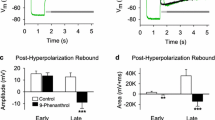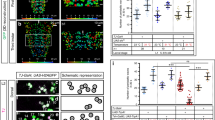1. Nitric oxide (NO) is thought to play a neuromodulatory role in the nervous system of vertebrate and invertebrate species. In the hornworm Manduca sexta, NO-mediated signaling has been implicated in behavioral and developmental processes, but its exact function in neurons is unknown. In this study, we identify specific neurons in the CNS of Manduca larvae that accumulate cGMP in response to treatment with NO donors in the presence of cGMP-phosphodiesterase inhibitors. Subsets of these neurons were identified as motoneuron-12 (MN12) and intersegmental motoneurons (ISMs), which innervate dorsal oblique muscles of the larvae.
2. To investigate the physiological role of NO-evoked increases in cGMP in these motoneurons we performed intracellular recordings; we found that application of NO donors caused an increase in neuronal excitability that was characterized by an increase in the spontaneous firing frequency. When action potentials and EPSPs were blocked, NO treatment evoked a depolarization of the resting membrane potential and a decrease in the measured input resistance in both MN12 and the ISMs.
3. Additional experiments with MN12 showed that treatment with the cGMP analogue, 8-Br-cGMP mimicked the NO effect on the resting potential and the input resistance. Furthermore, MN12 incubation with the NOS inhibitor, L-NNA, resulted in a small hyperpolarization of the resting potential and an increase in the input resistance, and incubation with the sGC inhibitor, ODQ blocked the NO-evoked depolarization of MN12. Finally, NO treatment during voltage clamping of MN12 evoked an inward positive current.
4. Taken together, these results suggest that NO can act as a “gain control” of neuronal excitability, which might have an important role in insect behavior.







Similar content being viewed by others
REFERENCES
Ball, E. E., and Truman, J. W. (1998). Developing grasshopper neurons show variable levels of guanylyl cyclase activity on arrival at their targets. J. Comp. Neurol. 394:1–13.
Bell, R. A., and Joachim, F. A. (1978). Techniques for rearing laboratory colonies of tobacco hornworms and pink bollworms. Ann. Entomol. Soc. Am. 69:365–373.
Bicker, G. (2001). Sources and targets of nitric oxide signalling in insect nervous systems. Cell Tissue Res. 303:137–146.
Colasanti, M., Lauro, G. M., and Venturini, G. (1995). NO in hydra feeding response. Nature 374:505.
Corson, D. W., Goodman, S., and Fein, A. (1979). An adaptation of the jet stream microelectrode beveler. Science 231:1302.
Denninger, J. W., and Marletta, M. A. (1999). Guanylate cyclase and the NO/cGMP signaling pathway. Biochim. Biophys. Acta 1411:334–350.
Elphick, M. R., Kemenes, G., Staras, K., and O’Shea, M. (1995). Behavioral role for nitric oxide in chemosensory activation of feeding in a mollusc. J. Neurosci. 15:7653–7664.
Esplugues, J. V. (2002). NO as a signalling molecule in the nervous system. Br. J. Pharmacol. 135:1079–1095.
Ewer, J., De Vente, J., and Truman, J. W. (1994). Neuropeptide induction of cyclic GMP increases in the insect CNS: Resolution at the level of single identifiable neurons. J. Neurosci. 14:7704–7712.
Ewer, J., and Truman, J. W. (1996). Increases in cyclic 3′,5′-guanosine monophosphate (cGMP) occur at ecdysis in an evolutionarily conserved crustacean cardioactive peptide-immunoreactive insect neuronal network. J. Comp. Neurol. 370:330–341.
Gammie, S. C., and Truman, J. W. (1997). An endogenous elevation of cGMP increases the excitability of identified insect neurosecretory cells. J. Comp. Physiol. A 180:329–337.
Garthwaite, J., and Boulton, C. L. (1995). Nitric oxide signaling in the central nervous system. Annu. Rev. Physiol. 57:683–706.
Hayashi, J. H., and Levine, R. B. (1992). Calcium and potassium currents in leg motoneurons during postembryonic development in the hawkmoth Manduca sexta. J. Exp. Biol. 171:15–42.
Hegstrom, C. D., and Truman, J. W. (1996). Synapse loss and axon retraction in response to local muscle degeneration. J. Neurobiol. 31:175–188.
Horikawa, K., and Armstrong, W. E. (1988). A versatile means of intracellular labeling: Injection of biocytin and its detection with avidin congugates. J. Neurosci. Methods 25:1–18.
Johnston, R. M., and Levine, R. B. (1996). Crawling motor patterns induced by pilocarpine in isolated larval nerve cords of Manduca sexta. J. Neurophysiol. 76:3178–3195.
Levine, R. B., and Truman, J. W. (1985). Dendritic reorganization of abdominal motoneurons during metamorphosis of the moth, Manduca sexta. J. Neurosci. 5:2424–2431.
McLean, D. L., and Sillar, K. T. (2002). Nitric oxide selectively tunes inhibitory synapses to modulate vertebrate locomotion. J. Neurosci. 22:4175–4184.
Miyazaki, S. (1980). The ionic mechanism of action potentials in neurosecretory cells and non-neurosecretory cells of the silkworm. J. Comp. Physiol. 140:43–52.
Moroz, L. L., Park, J. H., and Winlow, W. (1993). Nitric oxide activates buccal motor patterns in Lymnaea stagnalis. Neuroreport 4:643–646.
Morton, D. B. (1996). Neuropeptide-stimulated cyclic guanosine monophosphate immunoreactivity in the neurosecretory terminals of a neurohemal organ. J. Neurobiol. 29:341–353.
Nara, M., Dhulipala, P. D., Ji, G. J., Kamasani, U. R., Wang, Y. X., Matalon, S., and Kotlikoff, M. I. (2000). Guanylyl cyclase stimulatory coupling to K(Ca) channels. Am. J. Physiol. Cell Physiol. 279:C1938–C1945.
Newcomb, J. M., and Watson, W. H., 3rd (2002). Modulation of swimming in the gastropod Melibe leonina by nitric oxide. J. Exp. Biol. 205:397–403.
Nighorn, A., Gibson, N. J., Rivers, D. M., Hildebrand, J. G., and Morton, D. B. (1998). The nitric oxide-cGMP pathway may mediate communication between sensory afferents and projection neurons in the antennal lobe of Manduca sexta. J. Neurosci. 18:7244–7255.
Ott, S. R., Delago, A., and Elphick, M. R. (2004). An evolutionarily conserved mechanism for sensitization of soluble guanylyl cyclase reveals extensive nitric oxide-mediated upregulation of cyclic GMP in insect brain. Eur. J. Neurosci. 20:1231–1244.
Prast, H., and Philippu, A. (2001). Nitric oxide as modulator of neuronal function. Prog. Neurobiol. 64:51–68.
Qazi, S., and Trimmer, B. A. (1999). The role of nitric oxide in motoneuron spike activity and muscarinic-evoked changes in cGMP in the CNS of larval Manduca sexta. J. Comp. Physiol. A 185:539– 550.
Rast, G. F. (2001). Nitric oxide induces centrally generated motor patterns in the locust suboesophageal ganglion. J. Exp. Biol. 204:3789–3801.
Renganathan, M., Cummins, T. R., Hormuzdiar, W. N., Black, J. A., and Waxman, S. G. (2000). Nitric oxide is an autocrine regulator of Na(+) currents in axotomized C-type DRG neurons. J. Neurophysiol. 83:2431–2442.
Sandstrom, D. J., and Weeks, J. C. (1991). Reidentification of larval interneurons in the pupal stage of the tobacco hornworm, Manduca sexta. J. Comp. Neurol. 308:311–327.
Schachtner, J., Klaassen, L., and Truman, J. W. (1998). Metamorphic control of cyclic guanosine monophosphate expression in the nervous system of the tobacco hornworm, Manduca sexta. J. Comp. Neurol. 396:238–252.
Scholz, N., and Truman, J. (2000). Invertebrate models for studying NO-mediated signaling. In Steinbusch, H., et al. (eds.), Handbook of Chemical Neuroanatomy. Vol. 17: Functional Neuroanatomy of the Nitric Oxide System, Elsevier Science, Amsterdam, The Netherlands, pp. 417–441.
Scholz, N. L., de Vente, J., Truman, J. W., and Graubard, K. (2001). Neural network partitioning by NO and cGMP. J. Neurosci. 21:1610–1618.
Schuman, E. M., and Madison, D. V. (1994). Nitric oxide and synaptic function. Annu. Rev. Neurosci. 17:153–83.
Smith, W. A., Varghese, A. H., and Lou, K. J. (1993). Developmental changes in cyclic AMP-dependent protein kinase associated with increased secretory capacity of Manduca sexta prothoracic glands. Mol. Cell Endocrinol. 90:187–195.
Trimmer, B. A. (1994). Characterization of a muscarinic current that regulates excitability of an identified insect motoneuron. J. Neurophysiol. 72:1862–1873.
Trimmer, B. A., Aprille, J., and Modica-Napolitano, J. (2004). Nitric oxide signalling: Insect brains and photocytes. Biochem. Soc. Symp. 65–83.
Trimmer, B. A., Qazi, S., and Vermehren, A. (1998). The effects of nitric oxide on the control of abdominal muscles in larval Manduca sexta. Soc. Neurosci. Abst. 24:105.
Truman, J. W., De, V. J., and Ball, E. E. (1996). Nitric oxide-sensitive guanylate cyclase activity is associated with the maturational phase of neuronal development in insects. Development 122:3949–3958.
Weeks, J. C., and Jacobs, G. A. (1987). A reflex behavior mediated by monosynaptic connections between hair afferents and motoneurons in the larval tobacco hornworm, Manduca sexta. J. Comp. Physiol. 160:315–329.
Weeks, J. C., and Truman, J. W. (1984). Neural organization of peptide-activated ecdysis behaviors during the metamorphosis of Manduca sexta: II. Retention of the proleg motor pattern despite loss of the prolegs at pupation. J. Comp. Physiol. 155:423–433.
Wenzel, B., Kunst, M., Gunther, C., Ganter, G. K., Lakes-Harlan, R., Elsner, N., and Heinrich, R. (2005). Nitric oxide/cyclic guanosine monophosphate signaling in the central complex of the grasshopper brain inhibits singing behavior. J. Comp. Neurol. 488:129–139.
Wildemann, B., and Bicker, G. (1999). Developmental expression of nitric oxide/cyclic GMP synthesizing cells in the nervous system of Drosophila melanogaster. J. Neurobiol. 38:1–15.
Wingrove, J. A., and O’Farrell, P. H. (1999). Nitric oxide contributes to behavioral, cellular, and developmental responses to low oxygen in Drosophila. Cell 98:105–114.
Zayas, R. M., Molina, G. C., Siddiqui, S., and Trimmer, B. A. (2002a). Nitric oxide-induced behaviors in Manduca sexta larvae. Soc. Neurosci. Abstr. 27.
Zayas, R. M., Qazi, S., Morton, D. B., and Trimmer, B. A. (2000). Neurons involved in nitric oxide-mediated cGMP signaling in the tobacco hornworm, Manduca sexta. J. Comp. Neurol. 419:422–438.
Zayas, R. M., Qazi, S., Morton, D. B., and Trimmer, B. A. (2002b). Nicotinic-acetylcholine receptors are functionally coupled to the nitric oxide/cGMP-pathway in insect neurons. J. Neurochem. 83:421–431.
Zsombok, A., Schrofner, S., Hermann, A., and Kerschbaum, H. H. (2000). Nitric oxide increases excitability by depressing a calcium activated potassium current in snail neurons. Neurosci. Lett. 295:85–88.
ACKNOWLEDGMENTS
We thank Dr. Sara M. Lewis for her kind assistance with statistical analysis and Pfizer, Inc. for their gift of sildenafil citrate. This work was supported by National Science Foundation Grant IBN-0077812 (B.A.T.) and The American Psychological Association Minority Fellowship in Neuroscience (R.M.Z.).
Author information
Authors and Affiliations
Corresponding author
Rights and permissions
About this article
Cite this article
Zayas, R.M., Trimmer, B.A. Characterization of NO/cGMP-Mediated Responses in Identified Motoneurons. Cell Mol Neurobiol 27, 191–209 (2007). https://doi.org/10.1007/s10571-006-9091-3
Received:
Accepted:
Published:
Issue Date:
DOI: https://doi.org/10.1007/s10571-006-9091-3




